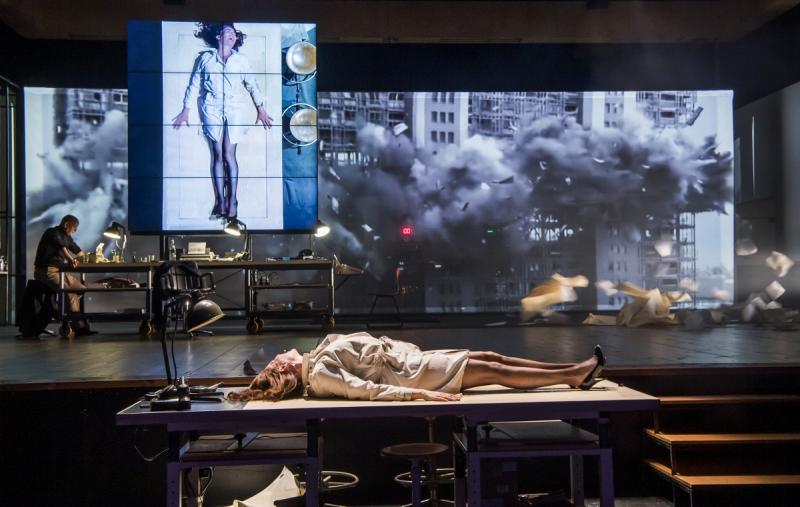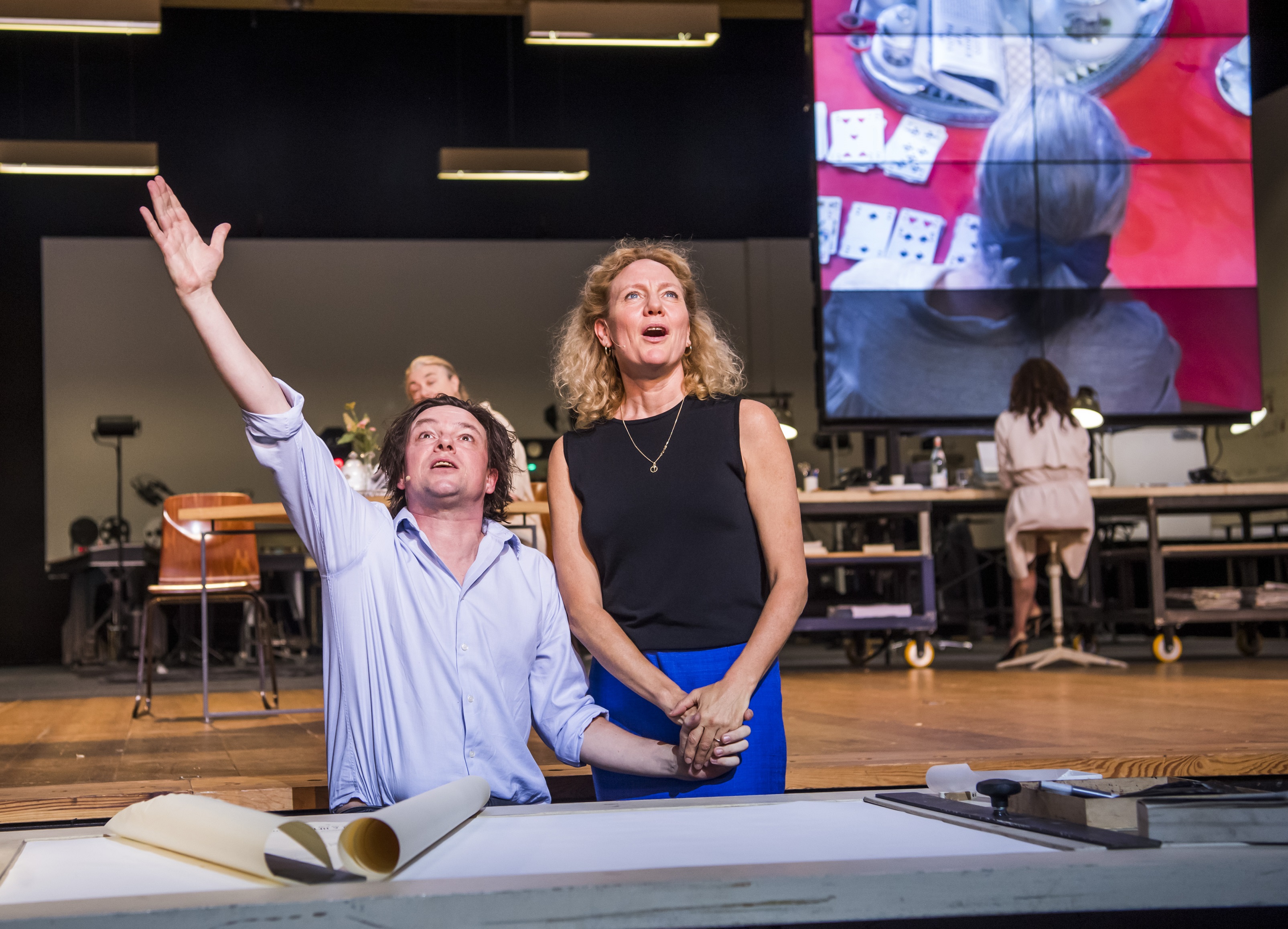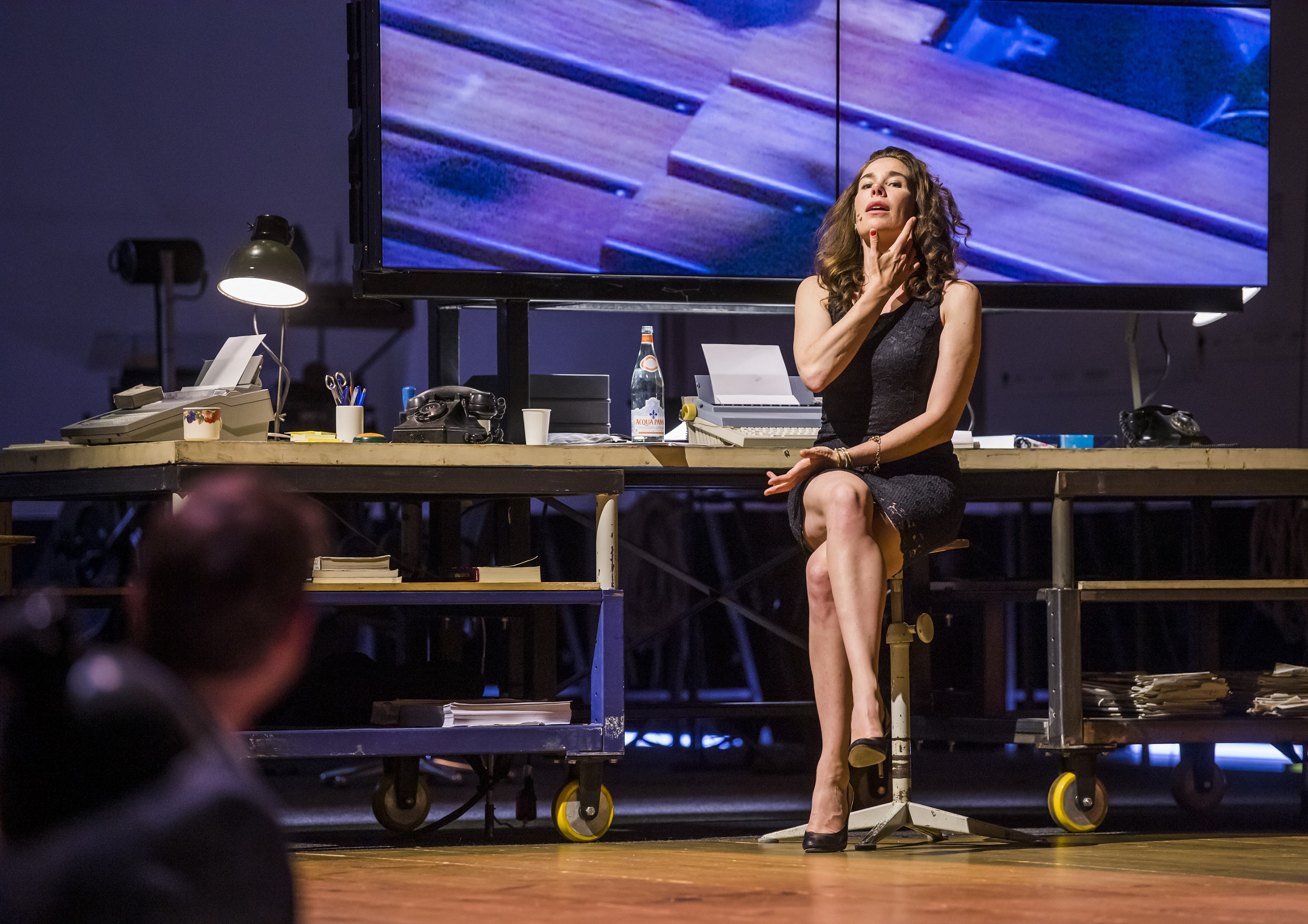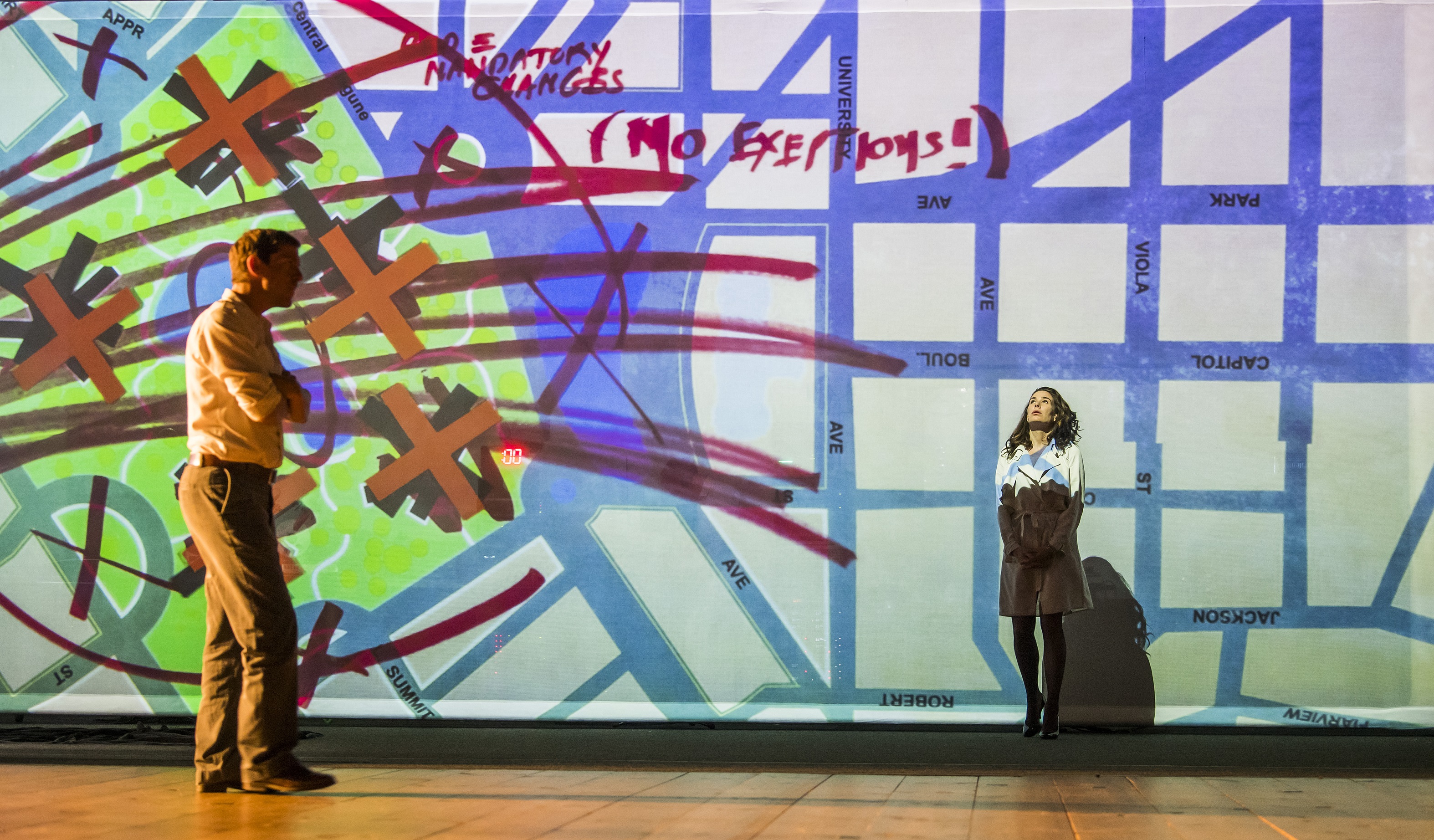The Fountainhead, The Lowry, Salford review – marathon in Mancland | reviews, news & interviews
The Fountainhead, The Lowry, Salford review – marathon in Mancland
The Fountainhead, The Lowry, Salford review – marathon in Mancland
Director of the moment Ivo van Hove explores an age-old conundrum

Ivo van Hove’s reputation precedes his work as a rumble of thunder goes before a storm.
First seen at Van Hove's home base on the continent just over five years ago, this is a marathon of a production (four hours plus), based on Ayn Rand’s pulpy 1943 novel of the same name, about a young American architect, Howard Roark, who is an original genius and knows it. Where others compromise their beliefs and go with convention and the demands of the market, he remains convinced of his own creative ability and integrity. The story sets up his relationships with Peter Keating (Aus Greidanus Jr, pictured above left with Halina Reijn), a friend since college days who is desperate for success but hasn’t an original idea in his body, and Ellsworth Toohey, an architecture journalist whose writing can make or break both people and projects. Intertwined is the contact Roark and Keating have with Dominique Francon, their boss’s daughter possessed of issues of her own. She finally marries press baron Gail Wynand but never loses her fascination with Roark and his genius.
The story sets up his relationships with Peter Keating (Aus Greidanus Jr, pictured above left with Halina Reijn), a friend since college days who is desperate for success but hasn’t an original idea in his body, and Ellsworth Toohey, an architecture journalist whose writing can make or break both people and projects. Intertwined is the contact Roark and Keating have with Dominique Francon, their boss’s daughter possessed of issues of her own. She finally marries press baron Gail Wynand but never loses her fascination with Roark and his genius.
It’s a long and winding saga, but even a summary is enough to show that we are in a kind of fantasy world where people exist the way one’s more lurid imaginary ideas might render them. Jan Versweyveld’s design concept captures this nonliteral way of thinking, utilising a big open stage lined with symbols of the architecture business. In contrast with the 1920s setting of the novel, there’s an indication here that the story could apply more interestingly to the 1960s and 1970s, when brutalist design and ambitious social housing projects were inescapable.
Van Hove’s skill lies in the clarity and impact of his direction and his embrace of mutliple art forms pressed into theatrical service. Live cameras and video close-ups pick out particular areas of the stage and those who populate it, and there is a clean, stark atmosphere to every aspect of the presentation. And when it comes to stagecraft, there could hardly be a bigger piece of theatrical shock and awe than the moment of demolition of a tower block, which comes with every device in the book: wind, smoke, dust, explosive sound and visual collapse all around. Nonetheless, the play remains one of ideas, in keeping with a book that has been compared (charitably, one might argue) to the dramatics of Wagner's Ring Cycle in its slowly uncurling storyline and lengthy soliloquies: the soundscape, too, gets rather Wagnerian at times.
And when it comes to stagecraft, there could hardly be a bigger piece of theatrical shock and awe than the moment of demolition of a tower block, which comes with every device in the book: wind, smoke, dust, explosive sound and visual collapse all around. Nonetheless, the play remains one of ideas, in keeping with a book that has been compared (charitably, one might argue) to the dramatics of Wagner's Ring Cycle in its slowly uncurling storyline and lengthy soliloquies: the soundscape, too, gets rather Wagnerian at times.
There’s a feeling that every so often you have been locked in a windowless room with Nietzsche, Wittgenstein and Adrian Mole all talking. The adaptation here may be the problem: perhaps more attention to the old adage of "Show, don’t tell" would have been worth it. Luckily, the performances are very good, particularly Ramsey Nasr as Roark (pictured below left). The actor conveys a sense of one not quite of this world who believes that to be the case. Halina Reijn's Dominique Francon exists as Roark's de facto female alter ego, someone more than the sum of her parts who nonetheless always reminds you that she is acting and that this is fantasyland. The sense of unreality is something you’re grateful for in the depictions of the book’s sex scenes – at least two of them extremely rough even if, as Van Hove insists, they are essentially consensual in the context of her psychology. Aus Greidanus Jnr, as Peter Keating, possesses a more recognisably everyday persona – eager to suck up to his boss, willing to cheat, a lying toad and very successful as a result – and makes him sympathetic at the same time. Janni Goslinga plays his put-upon girlfriend, Catherine, as a wimp (the story makes her one at first) who finally achieves a sort of nobility – which I liked. Bart Slegers's mean-minded journo Ellsworth Toohey may not resemble any of the species I’ve ever met but perhaps I've just been lucky. Hans Kesting, as the mighty magnate Wynand, may remind some of Robert Maxwell as he comes to dominate the story's second half.
Aus Greidanus Jnr, as Peter Keating, possesses a more recognisably everyday persona – eager to suck up to his boss, willing to cheat, a lying toad and very successful as a result – and makes him sympathetic at the same time. Janni Goslinga plays his put-upon girlfriend, Catherine, as a wimp (the story makes her one at first) who finally achieves a sort of nobility – which I liked. Bart Slegers's mean-minded journo Ellsworth Toohey may not resemble any of the species I’ve ever met but perhaps I've just been lucky. Hans Kesting, as the mighty magnate Wynand, may remind some of Robert Maxwell as he comes to dominate the story's second half.
It’s a pity that Hugo Koolschijn has to take two roles as different architecture firm bosses early on, which doesn’t help to clarify the storyline.The show was by no means sold out on first night: perhaps word got around in Mancland that, for all its devices, it was quite a tough sit. And in the end, for all the conviction that its message makes this a play for today, the result does little more than revive a longtime conundrum: great artists may have to be egotists, but do egotists have to be great artists?
rating
Explore topics
Share this article
Add comment
The future of Arts Journalism
You can stop theartsdesk.com closing!
We urgently need financing to survive. Our fundraising drive has thus far raised £49,000 but we need to reach £100,000 or we will be forced to close. Please contribute here: https://gofund.me/c3f6033d
And if you can forward this information to anyone who might assist, we’d be grateful.

Subscribe to theartsdesk.com
Thank you for continuing to read our work on theartsdesk.com. For unlimited access to every article in its entirety, including our archive of more than 15,000 pieces, we're asking for £5 per month or £40 per year. We feel it's a very good deal, and hope you do too.
To take a subscription now simply click here.
And if you're looking for that extra gift for a friend or family member, why not treat them to a theartsdesk.com gift subscription?
more Theatre
 Ragdoll, Jermyn Street Theatre review – compelling and emotionally truthful
Katherine Moar returns with a Patty Hearst-inspired follow up to her debut hit Farm Hall
Ragdoll, Jermyn Street Theatre review – compelling and emotionally truthful
Katherine Moar returns with a Patty Hearst-inspired follow up to her debut hit Farm Hall
 Troilus and Cressida, Globe Theatre review - a 'problem play' with added problems
Raucous and carnivalesque, but also ugly and incomprehensible
Troilus and Cressida, Globe Theatre review - a 'problem play' with added problems
Raucous and carnivalesque, but also ugly and incomprehensible
 Clarkston, Trafalgar Theatre review - two lads on a road to nowhere
Netflix star, Joe Locke, is the selling point of a production that needs one
Clarkston, Trafalgar Theatre review - two lads on a road to nowhere
Netflix star, Joe Locke, is the selling point of a production that needs one
 Ghost Stories, Peacock Theatre review - spirited staging but short on scares
Impressive spectacle saves an ageing show in an unsuitable venue
Ghost Stories, Peacock Theatre review - spirited staging but short on scares
Impressive spectacle saves an ageing show in an unsuitable venue
 Hamlet, National Theatre review - turning tragedy to comedy is no joke
Hiran Abeyeskera’s childlike prince falls flat in a mixed production
Hamlet, National Theatre review - turning tragedy to comedy is no joke
Hiran Abeyeskera’s childlike prince falls flat in a mixed production
 Rohtko, Barbican review - postmodern meditation on fake and authentic art is less than the sum of its parts
Łukasz Twarkowski's production dazzles without illuminating
Rohtko, Barbican review - postmodern meditation on fake and authentic art is less than the sum of its parts
Łukasz Twarkowski's production dazzles without illuminating
 Lee, Park Theatre review - Lee Krasner looks back on her life as an artist
Informative and interesting, the play's format limits its potential
Lee, Park Theatre review - Lee Krasner looks back on her life as an artist
Informative and interesting, the play's format limits its potential
 Measure for Measure, RSC, Stratford review - 'problem play' has no problem with relevance
Shakespeare, in this adaptation, is at his most perceptive
Measure for Measure, RSC, Stratford review - 'problem play' has no problem with relevance
Shakespeare, in this adaptation, is at his most perceptive
 The Importance of Being Earnest, Noël Coward Theatre review - dazzling and delightful queer fest
West End transfer of National Theatre hit stars Stephen Fry and Olly Alexander
The Importance of Being Earnest, Noël Coward Theatre review - dazzling and delightful queer fest
West End transfer of National Theatre hit stars Stephen Fry and Olly Alexander
 Get Down Tonight, Charing Cross Theatre review - glitz and hits from the 70s
If you love the songs of KC and the Sunshine Band, Please Do Go!
Get Down Tonight, Charing Cross Theatre review - glitz and hits from the 70s
If you love the songs of KC and the Sunshine Band, Please Do Go!
 Punch, Apollo Theatre review - powerful play about the strength of redemption
James Graham's play transfixes the audience at every stage
Punch, Apollo Theatre review - powerful play about the strength of redemption
James Graham's play transfixes the audience at every stage
 The Billionaire Inside Your Head, Hampstead Theatre review - a map of a man with OCD
Will Lord's promising debut burdens a fine cast with too much dialogue
The Billionaire Inside Your Head, Hampstead Theatre review - a map of a man with OCD
Will Lord's promising debut burdens a fine cast with too much dialogue

Comments
I attended the opening night